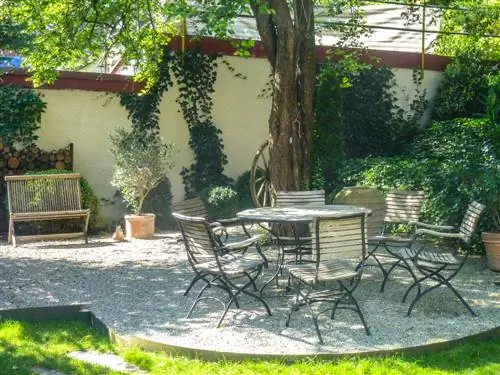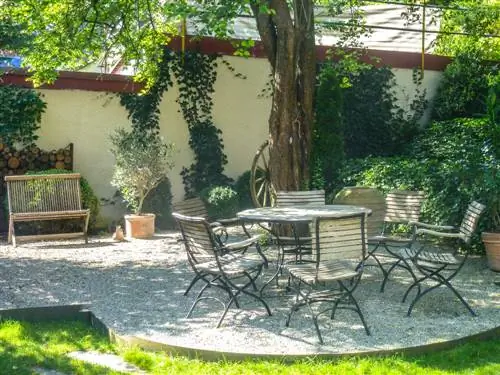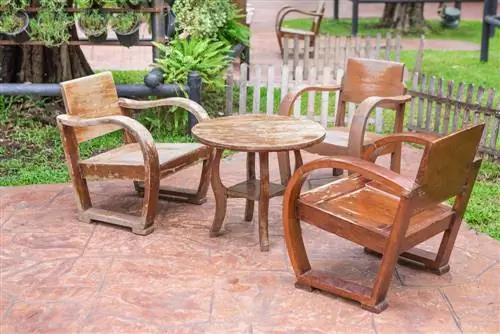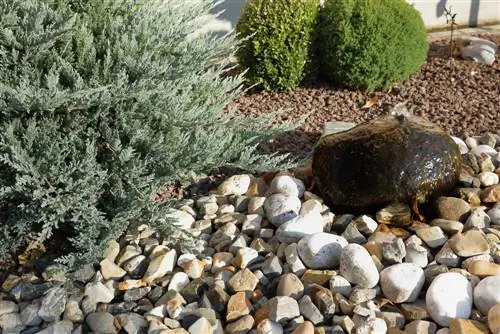- Author admin [email protected].
- Public 2023-12-16 16:46.
- Last modified 2025-01-23 11:21.
Stone is an extremely versatile material that can be used in a variety of ways in the garden. Whether for paving paths, fixing your favorite cozy seating area or the garage forecourt or building a privacy wall - there is the right material for every project. Stone is extremely varied and colorful, as you can choose from many different types.

For which areas of garden design are stones suitable?
Stones in garden design can be used for paths, garage forecourts, garden walls, stairs and terraces. Suitable materials include natural stones such as granite, sandstone, slate or marble, as well as concrete and clinker bricks for durability and versatility.
Observe legal regulations
In order to avoid trouble with the neighbors, you should obtain information about what is allowed and what is not, especially before building work on or near the neighboring property. As a rule, no inquiries to the building authorities are necessary for the construction of terraces and paths. If there are small border walls, privacy walls, privacy elements or larger buildings near the garden border, we recommend taking a look at the development plan, the local statutes or making an inquiry to the municipal or district office.
In which garden areas is stone worked?
Stone is used in many garden areas and allows you to create different garden spaces. Despite all your creativity, you should also make sure that access paths, garage entrances, terrace areas or simply paved paths through the vegetable garden must be functional, safe and sensibly designed so that you can enjoy them in the long term. The access path to the house will be wider and sturdier than the stepping stones to the cozy, hidden seating area in the corner of the garden. Garage forecourts, on the other hand, require a more durable surface than would be the case with a terrace.
Paths
Paths are not only a practical but also an important design element in the garden. The route and the choice of stones have a significant influence on how a garden is perceived: strictly formal through a straight route, interesting through curved paths with imaginative, colorful paving or unusual, for example through star-shaped, paved work paths in the vegetable garden. The following information is recommended when creating paths:
- Access routes should be paved or flagged, avoiding stumbling blocks.
- Lawn grid stones and other perforated stones are not suitable for main paths, but only for side paths.
- Reason: Ladies tend to get stuck here with their heels.
- Paths to the house entrance should be at least 120 centimeters wide
- Long paths appear shorter when paved with “horizontal stripes” or square patterns.
- Even large plate formats visually reduce the path.
- Short distances, on the other hand, appear more generous when working with small-format paving stones.
- A curved path makes short paths appear longer and creates visual tension.
- Small, separated squares that are integrated into the path also have a visually shortening effect.
- Paths that are less traveled can be covered with easy-care slabs, clinker bricks or paving stones.
Garden forecourts and front gardens
For the sake of your car, avoid garage forecourts that are too small. Even difficult-to-see obstacles such as boulders, low posts or walls have no place here. Instead, the substructure of garage entrances must be laid out particularly carefully in order to be able to withstand the larger loads. These places look exciting when you work with patterns and, for example, pave circles, squares or even mosaics.
Garden walls and stairs
Garden walls, no matter how high, always need a foundation to prevent them from tipping over. If the gradient is around ten percent, it is also recommended to install steps. These must be safe and trip-free to walk on. Wide, paved steps are useful for busy paths, while simple steps only make sense for accessing less frequented garden areas - such as side paths. Stairs and walls can be combined excellently and combined with water basins, sun terraces, seating areas or raised beds to form interesting units.
Terraces and seating
A wind- and view-protected terrace on the house that offers enough space for a seating area with tables and chairs is ideal. Smooth surfaces on which the furniture stands securely are preferred in the patio area. Second seating areas in the garden can also be given simpler coverings and can be designed in an exciting way: for example, you can “sink” such a place with the help of walls or attach it to a slope.
Which stones are suitable for use in the garden?
Your wallet often decides which stone is used in the garden. But environmental protection issues as well as the expected transport routes and costs should also be taken into account.
Natural stones
Natural stone is, as the name suggests, obtained from natural deposits. A rough distinction is made between hard and soft rock, which is important for processing and use in the garden. Hard rocks include granite, gneiss, porphyry and bas alt, which are very hard, frost-resistant and long-lasting. These stones are often used for walls and as paving stones, for stone steles and as edge stones. Examples of soft rock include all limestone, sandstone, slate and marble. They are easy to work with and are ideal as garden slabs and for building low walls and stairs.
Concrete and concrete blocks
Concrete is a stone-like material that, like natural stone, can be used in a variety of ways. This makes it a good alternative to the more expensive natural stones. Highly stressed areas in the garden can be covered with interlocking paving stones, the individual stones of which have a so-called wear layer. This is particularly hard and can withstand even the greatest demands.
Tip
Clinker brick is available in many shades of color and is therefore a very good alternative to natural stone, as well as because of its durability.






